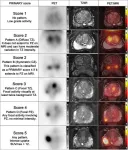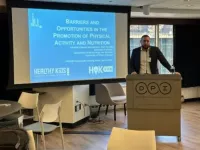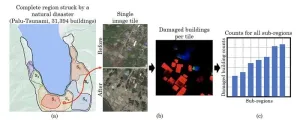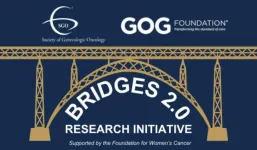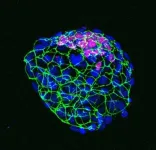(Press-News.org) Modern biology textbooks assert that only bacteria can take nitrogen from the atmosphere and convert it into a form that is usable for life. Plants that fix nitrogen, such as legumes, do so by harboring symbiotic bacteria in root nodules. But a recent discovery upends that rule.
In two recent papers, an international team of scientists describe the first known nitrogen-fixing organelle within a eukaryotic cell. The organelle is the fourth example in history of primary endosymbiosis — the process by which a prokaryotic cell is engulfed by a eukaryotic cell and evolves beyond symbiosis into an organelle.
“It’s very rare that organelles arise from these types of things,” said Tyler Coale, a postdoctoral scholar at UC Santa Cruz and first author on one of two recent papers. “The first time we think it happened, it gave rise to all complex life. Everything more complicated than a bacterial cell owes its existence to that event,” he said, referring to the origins of the mitochondria. “A billion years ago or so, it happened again with the chloroplast, and that gave us plants,” Coale said.
The third known instance involves a microbe similar to a chloroplast. The newest discovery is the first example of a nitrogen-fixing organelle, which the researchers are calling a nitroplast.
A decades-long mystery
The discovery of the organelle involved a bit of luck and decades of work. In 1998, Jonathan Zehr, a UC Santa Cruz distinguished professor of marine sciences, found a short DNA sequence of what appeared to be from an unknown nitrogen-fixing cyanobacterium in Pacific Ocean seawater. Zehr and colleagues spent years studying the mystery organism, which they called UCYN-A.
At the same time, Kyoko Hagino, a paleontologist at Kochi University in Japan, was painstakingly trying to culture a marine alga. It turned out to be the host organism for UCYN-A. It took her over 300 sampling expeditions and more than a decade, but Hagino eventually successfully grew the alga in culture, allowing other researchers to begin studying UCYN-A and its marine alga host together in the lab.
For years, the scientists considered UCYN-A an endosymbiont that was closely associated with an alga. But the two recent papers suggest that UCYN-A has co-evolved with its host past symbiosis and now fits criteria for an organelle.
Organelle origins
In a paper published in Cell in March, Zehr and colleagues from the Massachusetts Institute of Technology, Institut de Ciències del Mar in Barcelona and the University of Rhode Island show that the size ratio between UCYN-A and their algal hosts is similar across different species of the marine haptophyte algae Braarudosphaera bigelowii.
The researchers use a model to demonstrate that the growth of the host cell and UCYN-A are controlled by the exchange of nutrients. Their metabolisms are linked. This synchronization in growth rates led the researchers to call UCYN-A “organelle-like.”
“That's exactly what happens with organelles,” said Zehr. “If you look at the mitochondria and the chloroplast, it’s the same thing: they scale with the cell.”
But the scientists did not confidently call UCYN-A an organelle until confirming other lines of evidence. In the cover article of the journal Science, published today, Zehr, Coale, Kendra Turk-Kubo and Wing Kwan Esther Mak from UC Santa Cruz, and collaborators from the University of California, San Francisco, the Lawrence Berkeley National Laboratory, National Taiwan Ocean University, and Kochi University in Japan show that UCYN-A imports proteins from its host cells.
“That’s one of the hallmarks of something moving from an endosymbiont to an organelle,” said Zehr. “They start throwing away pieces of DNA, and their genomes get smaller and smaller, and they start depending on the mother cell for those gene products — or the protein itself — to be transported into the cell.”
Tyler Coale worked on the proteomics for the study. He compared the proteins found within isolated UCYN-A with those found in the entire algal host cell. He found that the host cell makes proteins and labels them with a specific amino acid sequence, which tells the cell to send them to the nitroplast. The nitroplast then imports the proteins and uses them. Coale identified the function of some of the proteins, and they fill gaps in certain pathways within UCYN-A.
“It’s kind of like this magical jigsaw puzzle that actually fits together and works,” said Zehr.
In the same paper, researchers from UCSF show that UCYN-A replicates in synchrony with the alga cell and is inherited like other organelles.
Changing perspectives
These independent lines of evidence leave little doubt that UCYN-A has surpassed the role of a symbiont. And while mitochondria and chloroplasts evolved billions of years ago, the nitroplast appears to have evolved about 100 million years ago, providing scientists with a new, more recent perspective on organellogenesis.
The organelle also provides insight into ocean ecosystems. All organisms need nitrogen in a biologically usable form, and UCYN-A is globally important for its ability to fix nitrogen from the atmosphere. Researchers have found it everywhere from the tropics to the Arctic Ocean, and it fixes a significant amount of nitrogen.
“It’s not just another player,” said Zehr.
The discovery also has the potential to change agriculture. The ability to synthesize ammonia fertilizers from atmospheric nitrogen allowed agriculture — and the world population — to take off in the early 20th century. Known as the Haber-Bosch process, it makes possible about 50% of the world’s food production. It also creates enormous amounts of carbon dioxide: about 1.4% of global emissions come from the process. For decades, researchers have tried to figure out a way to incorporate natural nitrogen fixation into agriculture.
“This system is a new perspective on nitrogen fixation, and it might provide clues into how such an organelle could be engineered into crop plants,” said Coale.
But plenty of questions about UCYN-A and its algal host remain unanswered. The researchers plan to delve deeper into how UCYN-A and the alga operate and study different strains.
Kendra Turk-Kubo, an assistant professor at UC Santa Cruz, will continue the research in her new lab. Zehr expects scientists will find other organisms with evolutionary stories similar to UCYN-A, but as the first of its kind, this discovery is one for the textbooks.
END
Scientists discover first nitrogen-fixing organelle
2024-04-11
ELSE PRESS RELEASES FROM THIS DATE:
PET/MRI accurately classifies prostate cancer patients, offers potential to avoid unnecessary biopsies
2024-04-11
Reston, VA—PET/MRI can improve diagnostic accuracy for prostate cancer patients and help avoid unnecessary biopsies, according to new research published in the April issue of The Journal of Nuclear Medicine. By applying the PRIMARY scoring system to PET/MRI results, researchers found that more than 80 percent of unnecessary biopsies could be avoided at the expense of missing one in eight clinically significant prostate cancer cases.
The Prostate Imaging Reporting and Data System (PI-RADS) is a five-point ...
Researchers test new behavioral health interventions
2024-04-11
The concept of “One Health” – which emphasizes the relationship between human, animal, plant and environmental health – has been gaining ground in scientific discussions in recent years. Brazilian and North American researchers developing research using this approach presented their work on Tuesday (April 9th), in Chicago (United States), during FAPESP Week Illinois.
One of the panelists was Eduardo Esteban Bustamante, a professor at the University of Illinois in Chicago. He talked about behavioral interventions that have been tested to promote physical activity and healthy eating – practices that, according to the researcher, ...
New computer vision tool wins prize for social impact
2024-04-11
AMHERST, Mass. – A team of computer scientists at the University of Massachusetts Amherst working on two different problems—how to quickly detect damaged buildings in crisis zones and how to accurately estimate the size of bird flocks—recently announced an AI framework that can do both. The framework, called DISCount, blends the speed and massive data-crunching power of artificial intelligence with the reliability of human analysis to quickly deliver reliable estimates that can quickly pinpoint and count specific features from very large collections ...
The Society of Gynecologic Oncology (SGO) and The GOG Foundation, Inc. (GOG-F) launch BRIDGES 2.0 Research Initiative with support from the Foundation for Women’s Cancer (FWC).
2024-04-11
PRESS RELEASE
Chicago, IL and Philadelphia, PA, USA, April 11, 2024: The Society of Gynecologic Oncology (SGO) and The GOG Foundation, Inc. (GOG-F) Launch BRIDGES 2.0 Research Initiative with support from the Foundation for Women’s Cancer (FWC). After a successful inaugural year, the SGO and the GOG-F join forces to collaborate, and proudly announce the launch of an expanded two-year clinical trial education program supported by the FWC. This important career and clinical trial development initiative aims to cultivate the next generation of investigators in gynecologic oncology and will focus on clinical and translational research ...
Embryos in hungry mouse mums postpone development
2024-04-11
It’s challenging to sustain a pregnancy when food is short, or conditions are otherwise tough. That’s why many mammalian embryos can postpone their growth to get through periods of environmental stress and then re-enter development when conditions improve. This stalling of development is known as embryonic diapause, and understanding the mechanisms behind it might help improve infertility treatments, such as embryo freezing. Now, researchers at the Center for Excellence in Brain Science and Intelligence Technology, the Chinese Academy of Sciences in Shanghai, China, have discovered how nutrient depletion is sensed by embryos growing in hungry mouse mums to induce diapause. ...
Scripps Research study reveals new approach for combatting “resting” bacteria
2024-04-11
LA JOLLA, CA—Most disease-causing bacteria are known for their speed: In mere minutes, they can double their population, quickly making a person sick. But just as dangerous as this rapid growth can be a bacterium’s resting state, which helps the pathogen evade antibiotics and contributes to severe chronic infections in the lungs and blood, within wounds, and on the surfaces of medical devices.
Now, Scripps Research scientists have discovered how long chains of molecules called polyphosphates (polyP) are needed for bacteria to slow down movements within cells and let them enter this resting ...
UT Health San Antonio appoints Anthony Francis as associate vice president for innovation and development
2024-04-11
SAN ANTONIO, April 10, 2024 – The University of Texas Health Science Center at San Antonio (UT Health San Antonio) has appointed Anthony Francis, a renowned leader in translating research to market opportunity, as associate vice president for innovation and development in the Office of the Vice President for Research.
He joins the institution from the University of California San Francisco, where he was executive director of the Office of Technology Management and Advancement. Francis is credited with transforming ...
Study finds increased anxiety and PTSD among people who remained in Ukraine
2024-04-11
Researchers from the International Blast Injury Research Network at the University of Southampton conducted a survey to understand how the mental health of displaced Ukrainians has been affected by the ongoing war. Their findings, published in PLOS Global Public Health, describe high levels of post-traumatic stress disorder (PTSD) and generalized anxiety among both refugees and people displaced within Ukraine.
Since the Russian invasion of Ukraine began in February 2022, at least 13 million people have been displaced from their homes. Both exposure ...
Image-based artificial intelligence spots parasitic worm infections in children's stool samples
2024-04-11
Image-based artificial intelligence spots parasitic worm infections in children's stool samples, particularly light intensity infections that may be missed by manual microscopy.
#####
Article URL: http://journals.plos.org/plosntds/article?id=10.1371/journal.pntd.0012041
Article Title: Diagnosis of soil-transmitted helminth infections with digital mobile microscopy and artificial intelligence in a resource-limited setting
Author Countries: Finland, Kenya, Sweden
Funding: This research was financially supported by The Erling-Persson Foundation (grant number 2021 0110) JL, Vetenskapsrådet (grant number 2021-04811) JL, Finska Läkaresällskapet ...
Scientists use wearable technology to detect stress levels during sleep
2024-04-11
What if changes in a person’s stress levels could be detected while they sleep using wearable devices? A new study by University of Vermont researchers published today in PLOS Digital Health is the first to find changes in perceived stress levels reflected in sleep data—an important step towards identifying biomarkers that may help flag individuals in need of support.
Given how critical sleep is to physical and mental health, the research team suspected signals might exist in sleep data, says Laura Bloomfield, a research assistant professor of mathematics and statistics and lead author of the study. “Changes in stress are visible.”
When parsing baseline sleep ...
